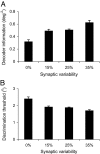Efficient coding in heterogeneous neuronal populations
- PMID: 18854413
- PMCID: PMC2571028
- DOI: 10.1073/pnas.0807744105
Efficient coding in heterogeneous neuronal populations
Abstract
A ubiquitous feature of neuronal responses within a cortical area is their high degree of inhomogeneity. Even cells within the same functional column are known to have highly heterogeneous response properties when the same stimulus is presented. Whether the wide diversity of neuronal responses is an epiphenomenon or plays a role for cortical function is unknown. Here, we examined the relationship between the heterogeneity of neuronal responses and population coding. Contrary to our expectation, we found that the high variability of intrinsic response properties of individual cells changes the structure of neuronal correlations to improve the information encoded in the population activity. Thus, the heterogeneity of neuronal responses is in fact beneficial for sensory coding when stimuli are decoded from the population response.
Conflict of interest statement
The authors declare no conflict of interest.
Figures




References
-
- Staiger JF, et al. Functional diversity of layer IV spiny neurons in rat somatosensory cortex: Quantitative morphology of electrophysiologically characterized and biocytin labeled cells. Cereb Cortex. 2004;14:690–701. - PubMed
Publication types
MeSH terms
LinkOut - more resources
Full Text Sources

